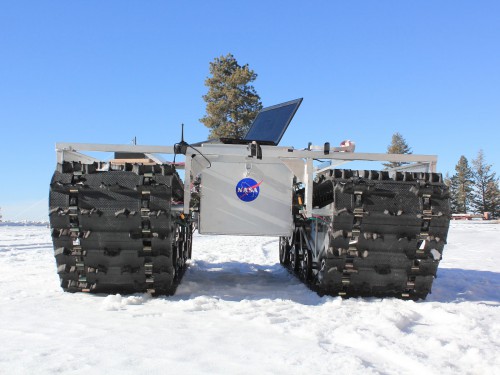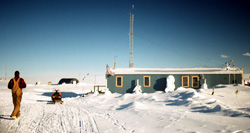
NASA’s newest scientific rover was due to commence testing yesterday (Friday), kicking off an ambitious five-week mission to explore the northern ice sheet of Greenland, which exhibited higher than normal surface melting last summer. The “GROVER” mission—whose acronym stands for both “Greenland Rover” and “Goddard Remotely Operated Vehicle for Exploration and Research”—will trek across the highest elevations in Greenland, using ground-penetrating radar to enable scientists to understand how snow accumulates and contributes to the evolution of the ice sheet over time.
Investigators at NASA’s Goddard Space Flight Center in Greenbelt, Md., expect GROVER to detect the layer of ice which formed in the aftermath of last year’s extreme melting event. It is believed that autonomous, solar-powered robotic vehicles will cost substantially less to operate than aircraft or satellites. According to Goddard glaciologist Lora Koenig, a GROVER science advisor, such vehicles provide “a new tool for glaciology studies.”
The 800-pound, tank-like rover measures about six feet tall and was developed in 2010-11 by teams of students participating in summer engineering boot camps at Goddard. They approached Koenig to ask if an autonomous rover could aid her studies of snow accumulation on ice sheets. This information is presently gathered by aircraft or radar mounted aboard snowmobiles. Together with Boise State University glaciologist Hans-Peter Marshall, the team fine-tuned the concept, with NASA funding, to produce a vehicle whose reliance upon solar power makes it possible to operate in pristine polar environments, without contributing to atmospheric pollution. GROVER’s solar panels are mounted in an inverted “V” shape, allowing them to gather energy from the Sun and sunlight reflected from the ice sheet.

The rover’s ground-penetrating radar is powered by two rechargeable batteries on the back of the vehicle. GROVER will be deployed from Summit Camp, a research station operated by the National Science Foundation, where the ice sheet is about two miles thick. It will crawl at speeds of about 1.2 mph and because the Sun never dips below the horizon during the Arctic summer it can work, uninterrupted, day and night. Koenig’s team will keep it within three miles of their camp at the start of the test, communicating with it via Wi-Fi, although the bulk of the research is expected to be conducted later in the mission, as GROVER roams further afield and transmits data in real time.
Ultimately, the plan is for investigators to control the rover from their desks. “We think it’s really powerful,” said Boise State University master’s degree student Gabriel Trisca, who developed the rover’s software. “The fact is the robot could be anywhere in the world and we’ll be able to control it from anywhere.”
GROVER will be joined on the ice sheet in June by another vehicle, the “Cool Robot,” which was developed at Dartmouth College in Hanover, N.H., with funding from the National Science Foundation. This latter mission will tow a variety of instruments for glaciological and atmospheric sensing applications.
Want to keep up-to-date with all things space? Be sure to “Like” AmericaSpace on Facebook and follow us on Twitter:@AmericaSpace



